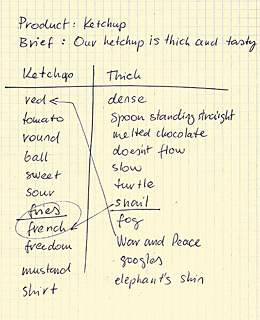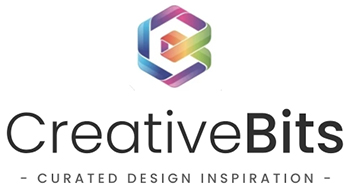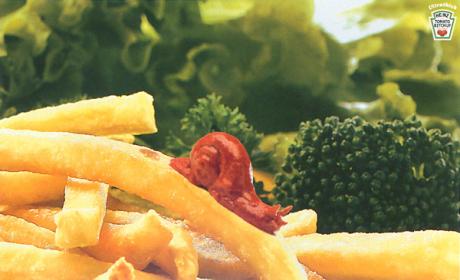Do you believe coming up with a creative idea is a matter of luck? I don’t. I think creativity is strategic thinking. It can be a well defined process that almost guarantees an idea every time.
Unfortunately there is no single recipe that works for everyone. The working process is different for every creative person. If you ask 10 successful designers and admans they will give you 10 different answers as to how they come up with ideas.
You have to develop your own methods. You need to try many different things and track their success. With time you will find and fine tune your own technique that works the best for you. The fastes way to do that is to learn from other people’s methods and mold them into your own style.
Let me share one technique I call pairing that I use to come up with creative concepts fairly quickly. The example is simulated, therefore there may be logical gaps, but it’s not important for the comprehension of the method. I reconstructed the thought process just to explain the process. I’ve used this technique many times and it’s the most rewarding for me for projects, which have a clear selling point for a product. In this example I’m talking about advertising, but the same technique can be applied for an annual report, a logo or any other creative job.
As a first step you need to collect all the information that you have about the job. Read through it carefully and distill the information down to the basics. If you have a planner you are lucky and this tedious process will be done for you. But if you’re a freelancer or working in a small studio you will have to do it yourself. You may receive a brief of 10 pages that discusses everything from the history of the company to the latest decisions on the board of directors, but all you need is a few words that best describe the brand you want to sell.
 Once I get down to the basics, I write the words down on a single piece of paper and I don’t look at the brief anymore. I can’t cover all the issues the brand needs to tackle when coming up with an idea. The issues are in the back of my head, but I need to focus on those few important elements for now. And I can come back to secondary issues later once the main idea is cracked.
Once I get down to the basics, I write the words down on a single piece of paper and I don’t look at the brief anymore. I can’t cover all the issues the brand needs to tackle when coming up with an idea. The issues are in the back of my head, but I need to focus on those few important elements for now. And I can come back to secondary issues later once the main idea is cracked.
So in our example case the product is Ketchup and the brief is to communicate that this ketchup is thick. In other words there is real tomato pulp in this product and it’s not just a watered up tomato flavor sauce.
As a first thing I put down on paper the name of the product. Below I write down an oversimplified brief. Next, I set up two or three columns with the key elements of the brief as the title row. In my example the keywords are Ketchup and Thick.
Now, I take each keyword and start to play a game of word association. I write down each word that comes to my mind in a long list. It’s easy because at each step I only need to concentrate on the last word. When I’m stuck for a second I look at the keyword again and start over from a different angle of thought and continue to fill up the column.
I won’t stop until I have at least 15 words listed for each keyword. Next, I start to take each word and pair it with words in other columns. For example I have the word “red” in the Ketchup column. I try to pair it up with words in the Thick column, such as “dense”, “spoon”, etc. and see if there is an idea in combining them. How can red be dense? How can red be spoon? Or spoon be red? I play around with each nonsensical statement.
Many seeds of ideas should come out of this exercise. In this example the words french and snail have caught my attention and I’m checking if there is something in them… Than I think of french fries and snail… Sounds disgusting, but I keep thinking what can a snail do with fries… Than I think about a red snail… Why not do a snail made of ketchup?.. But, it would not look like ketchup on it’s own, rather it would look like a bloody snail… But, if I put it on fries at first sight it will indeed look like ketchup. Got it. See the finished ad below by Leo Burnett, New Delhi.
This technique may seem random and uncertain, but creativity is about combining seemingly unrelated things and creating a new idea from these elements. The exercise gives you freedom, but makes you think about the subject in detail long enough to connect those seemingly unrelated things.
It may not work for you as I described, but hopefully you can take this technique and mold it to your own preference.
To be effective in the word association game and in connecting the dots you need to condition your brain. Read all about how to keep your creative juices flowing in a previous post.

